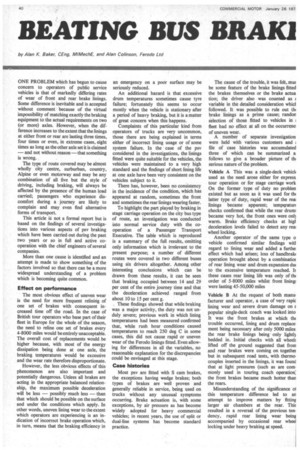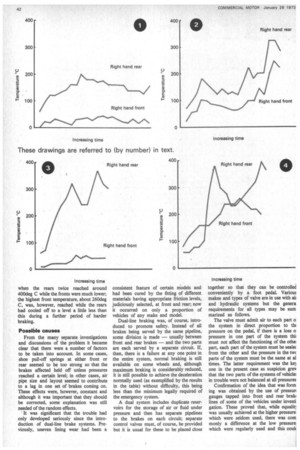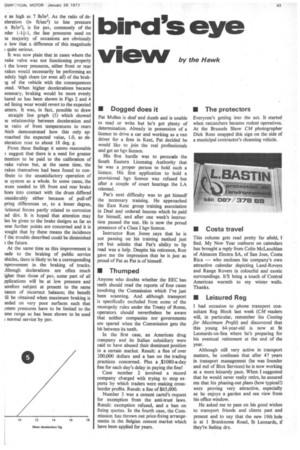BEATING BUS BRAM BURN-OUT
Page 42

Page 43

Page 44

Page 45

If you've noticed an error in this article please click here to report it so we can fix it.
by Alan K. Baker, CEng, IVIIMechE, and Alan Colinson, Ferodo Ltd
ONE PROBLEM which has begun to cause concern to operators of public service vehicles is that of markedly differing rates of wear of front and rear brake linings. Some difference is inevitable and is accepted without comment because of the virtual impossibility of matching exactly the braking equipment to the actual requirements on two (or more) axles. However, when the difference increases to the extent that the linings at either front or rear are lasting three times, four times or even, in extreme cases, eight times as long as the other axle set it is claimed — and not without reason —that something is wrong.
The type of route covered may be almost wholly city centre, surburban, country, Alpine or even motorway and may be any combination of all five but the style of driving, including braking, will always be affected by the presence of the human load carried; passengers who experience discomfort during a journey are likely to complain and may even find alternative forms of transport.
This article is not a formal report but is based on the findings of several investigations into various aspects of psv braking which have been carried out during the past two years or so in full and active cooperation with the chief engineers of several companies.
More than one cause is identified and an attempt is made to show something of the factors involved so that there can be a more widespread understanding of a problem which is becoming quite common.
Effect on performance The most obvious effect of uneven wear is the need for more frequent relining of one set of brakes with consequent increased time off the road. In the case of British tour operators who base part of their fleet in Europe for the whole of the season, the need to reline one set of brakes every 4-8000 miles would be entirely unacceptable. The overall cost of replacements would be higher because, with most of the energy dissipation being done at one axle, the braking temperatures would be excessive and the wear rate therefore disproportionate.
However, the less obvious effects of this phenomenon are also important and potentially dangerous. Unless all brakes are acting in the appropriate balanced relationship, the maximum possible deceleration will be less — possibly much less — than that which should be possible on the surface and under the conditions which apply. In other words, uneven lining wear to the extent which operators are experiencing is an indication of incorrect brake operation which, in turn, means that the braking efficiency in an emergency on a poor surface may be seriously reduced.
An additional hazard is that excessive drum temperatures sometimes cause tyre failure; fortunately this seems to occur mostly when the vehicle is stationary after a period of heavy braking, but it is a matter of great concern when this happens.
Complaints of this particular kind from operators of trucks are very uncommon, those there are being explained in terms either of incorrect lining usage or of some system failure. In the case of the psv considered in the investigations, the linings fitted were quite suitable for the vehicles, the vehicles were maintained to a very high standard and the findings of short lining life at one axle have been very consistent on the vehicles subject to it.
There has, however, been no consistency in the incidence of the condition, which has appeared at random, sometimes the front and sometimes the rear linings wearing faster.
To highlight the part played by braking in stage carriage operation on the city bus type of route, an investigation was conducted into normal service duty with the cooperation of a Passenger Transport Executive. The table which is reproduced is a summary of the full results, omitting only information which is irrelevant to the present purpose; a number of different routes were covered in two different buses using six drivers altogether. Among other interesting conclusions which can be drawn from these results, it can be seen that braking occupied between 14 and 29 per cent of the entire journey time and that the deceleration achieved ranged from about 10 to 15 per cent g.
These findings showed that while braking was a major activity, the duty was not unduly severe; previous work in which lining temperatures had been measured confirmed that, while rush hour conditions caused temperatures to reach 250 deg C in some cases, this did not cause rapid or uneven wear of the Ferodo linings fitted. Even allowing for differences in all the variables, no reasonable explanation for the discrepancies could be envisaged at this stage.
Case histories Most psv are fitted with S cam brakes, the exceptions having wedge brakes; both types of brakes are well proven and generally reliable in service, being used on trucks without any unusual symptoms occurring. Brake actuation is, with some exceptions, by air pressure as has become widely adopted for heavy commercial vehicles; in recent years, the use of split or dual-line systems has become standard practice. The cause of the trouble, it was felt, mus be some feature of the brake linings fitted the brakes themselves or the brake actua tion; the driver also was counted as variable in the detailed consideration whici followed. It was possible to rule out th( brake linings as a prime cause; randon selection of those fitted to vehicles in ; fleet had no effect at all on the occurrenc of uneven wear.
A number of separate investigation were held with various customers and file of case histories was accumulated three of which can be summarized a follows to give a broader picture of thi serious nature of the problem.
Vehicle A This was a single-deck vehich used as the need arose either for express, tour operation or for stage carriage work On the former type of duty no problen existed but as soon as it was used for th( latter type of duty, rapid wear of the real linings became apparent; temperatur( checks confirmed that while the rear drum: became very hot, the front ones were onl} warm. Brake efficiency checks at higt deceleration levels failed to detect any real wheel locking.
Another operator of the same type o vehicle confirmed similar findings witl regard to lining wear and added a furthe effect which had arisen; loss of handbrak( operation brought about by a combinatior of rear lining wear and drum expansion du( to the excessive temperature reached. It these cases rear lining life was only of th( order of 5-8000 miles whilst front lining: were lasting 45-50,000 miles
Vehicle B At the request of both manufacturer and operator, a case of very rapic lining wear and severe drum damage on E popular single-deck coach was looked into It was the front brakes at which flit trouble occurred, lining and drum replace. ment being necessary after only 5000 miles the rear brake linings being only lightly bedded in. Initial checks with all wheel: lifted off the ground suggested that from and rear brakes were coming on together but in subsequent road tests, with thermocouples inserted in the linings, it was found that at light pressures (such as are commonly used in touring coach operation', the front brakes became much hotter than the rears.
Misunderstanding of the significance oi this temperature difference led to an attempt to improve matters by fitting larger air chambers at the rear. This resulted in a reversal of the previous tendency, rapid rear lining wear being accompanied by occasional rear wheel locking under heavy braking at speed.
'aide C One major operator was Kperiencing rear/front lining wear in the ttio 4:1 with a single-deck vehicle. This perator was anxious to investigate the tatter fully and the vehicle, with thermoauples fitted into the linings, was Lstrumented and used for a routine pre:ason driver familiarization run which )ok it into six Continental countries and yvered some 3000 miles. Ten experienced rivers took part in the run, which included wen descents of major alpine passes, id a Ferodo observer was present to .isist and take note of any special circumances; a large mass of data was accumuted and the following represents only a immary of part of the full report. After the ontinental trip, two further days were t.ent on the Ferodo commercial vehicle rcuit in Derbyshire to obtain additional ita on roads well known to Ferodo igineers.
Because of the special nature of the miliarization run as distinct from a assenger carrying tour, the average speeds were a little higher than would generally be the case but not to any excessive degree. Differences in front and rear brake temperatures were observed from the beginning, those at the rear being higher than those at the front; at the higher decelerations the differences were less while at the low decelerations, which were the normal standard for touring duty, the front brakes hardly became warm.
These findings are best illustrated by plotting the results of some of the alpine descents which were of sufficient duration for the temperatures to stabilize section by section and give a meaningful reading.
The first of these (1) is from the Col de la Croix Haute in France, the summit of which is at 3853ft; speed was low as were decelerations because of the poor condition of the road surface and the presence of a certain amount of ice. It can be seen clearly that while rear brake temperatures rose to almost 200dege C, the fronts never exceeded 40deg C which is little above human body temperature; on this descent
and the next described, the brakes are used because of the numerous bends rather than because of the gradient.
A little later, still in France, the route crossed the Col de Leques at 3762ft where the roads were better and a different driver negotiated the descent at a higher average speed with infrequent but heavier brake applications. The plotted temperatures (2) show now an entirely different picture, the rears still being the higher but with the fronts following an identical pattern some 50deg C lower, The third example (3), the Aachansee Pass between Innsbruck and Salzburg in Austria, was made with very frequent but light applications during the I200ft descent. Again, as can be seen, the front brake temperatures remained very low but the rears rose to about 365deg C. Finally (4), during the descent from the Black Forest in Germany, the brakes were at first used very hard and the front temperatures were for some time higher than the rears by up to 75deg C. Later the situation was reversed when the rears twice reached around 400deg C while the fronts were much lower; the highest front temperature, about 260deg C, was, however, reached while the rears had cooled off to a level a little less than this during a further period of harder braking.
Possible causes From the many separate investigations and discussions of the problem it became clear that there were a number of factors to be taken into account. In some cases, shoe pull-off springs at either front or rear seemed to be too strong so that the brakes affected held off unless pressures reached a certain level; in other cases, air pipe size and layout seemed to contribute to a lag in one set of brakes corning on. These effects were, however, constant and although it was important that they should be corrected, some explanation was still needed of the random effects.
It was significant that the trouble had only developed seriously since the introduction of dual-line brake systems. Previously, uneven lining wear had been a consistent feature of certain models and had been cured by the fitting of different materials having appropriate friction levels, judiciously selected, at front and rear; now it occurred on only a proportion of vehicles of any make and model.
Dual-line braking was, of course, introduced to promote safety. Instead of all brakes being served by the same pipeline, some division is made — usually between front and rear brakes — and the two parts are each served by a separate circuit. If, then, there is a failure at any one point in the entire system, normal braking is still available on some wheels and, although maximum braking is considerably reduced, it is still possible to achieve the deceleration normally used (as exemplified by the results in the table) without difficulty, this being less than the minimum legally required of the emergency system.
A dual system includes duplicate reservoirs for the storage of air or fluid under pressure and then has separate pipelines to the brakes on each circuit; separate control valves must, of course, be provided but it is usual for these to be placed close together so that they can be controllee conveniently by a foot pedal. Various makes and types of valve are in use with as and hydraulic systems but the genera requirements for all types may be sum marized as follows.
The valve must admit air to each part o the system in direct proportion to th( pressure on the pedal, if there is a loss o pressure in one part of the system thi: must not affect the functioning of the aim part, each part of the system must be wale( from the other and the pressure in the twt parts of the system must be the same at al times. The latter requirement was the kel one in the present case as suspicion grey that the two parts of the systems of vehicle; in trouble were not balanced at all pressures Confirmation of the idea that was form ing was obtained by the use of pressuri gauges tapped into front and rear bralo lines of some of the vehicles under investi gation. These proved that, while equalit: was usually achieved at the higher pressure which were seldom used, there was coin monly a difference at the low pressure which were regularly used and this coul■
e as high as 7 lb/in2. As the ratio of deeleration (in ft/sec') to line pressure n lb/in2), is for psv, commonly of the rder 1-11:1, the line pressures used on le majority of occasions are obviously o low that a difference of this magnitude ; quite serious.
It was now plain that in cases where the rake valve was not functioning properly t the lower pressures, either front or rear rakes would necessarily be performing an nduly high share (or even all) of the brakig of the vehicle with the consequences oted. When higher decelerations became ecessary, braking would be more evenly hared as has been shown in Figs 2 and 4 nd lining wear would revert to the expected attem. It was, in fact, possible to draw straight line graph (5) which showed le relationship between deceleration and le ratio of front temperatures to rears thich demonstrated how this only aproached the expected value, 1.0, as deeleration rose to about 18 deg. g.
From these findings it seems reasonable ) suggest that there is a need for greater ttention to be paid to the calibration of rake valves but, at the same time, the rakes themselves had been found to conibute to the unsatisfactory operation of le system as a whole. In some cases, the mces needed to lift front and rear brake hoes into contact with the drum differed onsiderably either because of pull-off pring differences or, to a lesser degree, ictional forces partly related to corrosion nd dirt. It is hoped that attention may lso be given to the brake designs as far as iese further points are concerned and it is lought that by these means the incidence f the trouble described could be diminished the future.
At the same time as this improvement is lade to the braking of public service ehicles, there is likely to be a corresponding nprovement in the braking of trucks. dthough declerations are often much igher than those of psv, some part of all pplications will be at low pressure and rerefore subject at present to the same hance of incorrect balance; the benefit ill be obtained when maximum braking is eeded on very poor surfaces such that yrstem pressures have to be limited to the tine range as has been shown to be used ; normal service by psv.




























































































